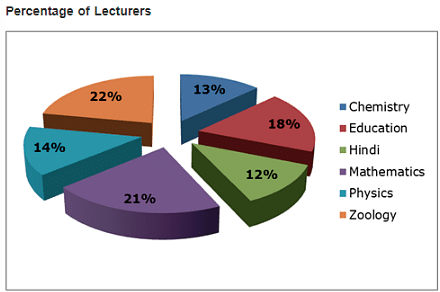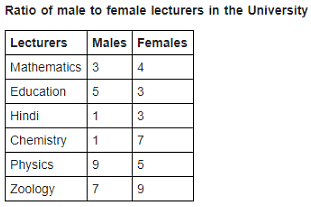CAT Exam > CAT Questions > Directions for Questions: Study the followin...
Start Learning for Free
Directions for Questions: Study the following Pie-chart and the table given below it carefully to answer these questions.
Percentage-wise Distribution of lecturers in six different subjects in a university Total Number of Lecturers: 1600
Percentage of Lecturers


What is the ratio of the number of female lecturers in Physics to the number of male lecturers in Mathematics?
- a)5:9
- b)2:9
- c)3:7
- d)5:3
Correct answer is option 'A'. Can you explain this answer?
| FREE This question is part of | Download PDF Attempt this Test |
Most Upvoted Answer
Directions for Questions: Study the following Pie-chart and the table...
Number of lecturers in Physics = 14% of 1600 = 224
Number of female lecturers in Physics = (5/14) X 224 = 80
Number of lecturers in mathematics = 21% of 1600 = 336
Number of male lecturers in mathematics = (3/7) X 336 = 144
Ratio = 80 : 144 = 5:9
Attention CAT Students!
To make sure you are not studying endlessly, EduRev has designed CAT study material, with Structured Courses, Videos, & Test Series. Plus get personalized analysis, doubt solving and improvement plans to achieve a great score in CAT.

|
Explore Courses for CAT exam
|

|
Similar CAT Doubts
Directions for Questions: Study the following Pie-chart and the table given below it carefully to answer these questions.Percentage-wise Distribution of lecturers in six different subjects in a university Total Number of Lecturers: 1600Percentage of LecturersWhat is the ratio of the number of female lecturers in Physics to the number of male lecturers in Mathematics?a)5:9b)2:9c)3:7d)5:3Correct answer is option 'A'. Can you explain this answer?
Question Description
Directions for Questions: Study the following Pie-chart and the table given below it carefully to answer these questions.Percentage-wise Distribution of lecturers in six different subjects in a university Total Number of Lecturers: 1600Percentage of LecturersWhat is the ratio of the number of female lecturers in Physics to the number of male lecturers in Mathematics?a)5:9b)2:9c)3:7d)5:3Correct answer is option 'A'. Can you explain this answer? for CAT 2024 is part of CAT preparation. The Question and answers have been prepared according to the CAT exam syllabus. Information about Directions for Questions: Study the following Pie-chart and the table given below it carefully to answer these questions.Percentage-wise Distribution of lecturers in six different subjects in a university Total Number of Lecturers: 1600Percentage of LecturersWhat is the ratio of the number of female lecturers in Physics to the number of male lecturers in Mathematics?a)5:9b)2:9c)3:7d)5:3Correct answer is option 'A'. Can you explain this answer? covers all topics & solutions for CAT 2024 Exam. Find important definitions, questions, meanings, examples, exercises and tests below for Directions for Questions: Study the following Pie-chart and the table given below it carefully to answer these questions.Percentage-wise Distribution of lecturers in six different subjects in a university Total Number of Lecturers: 1600Percentage of LecturersWhat is the ratio of the number of female lecturers in Physics to the number of male lecturers in Mathematics?a)5:9b)2:9c)3:7d)5:3Correct answer is option 'A'. Can you explain this answer?.
Directions for Questions: Study the following Pie-chart and the table given below it carefully to answer these questions.Percentage-wise Distribution of lecturers in six different subjects in a university Total Number of Lecturers: 1600Percentage of LecturersWhat is the ratio of the number of female lecturers in Physics to the number of male lecturers in Mathematics?a)5:9b)2:9c)3:7d)5:3Correct answer is option 'A'. Can you explain this answer? for CAT 2024 is part of CAT preparation. The Question and answers have been prepared according to the CAT exam syllabus. Information about Directions for Questions: Study the following Pie-chart and the table given below it carefully to answer these questions.Percentage-wise Distribution of lecturers in six different subjects in a university Total Number of Lecturers: 1600Percentage of LecturersWhat is the ratio of the number of female lecturers in Physics to the number of male lecturers in Mathematics?a)5:9b)2:9c)3:7d)5:3Correct answer is option 'A'. Can you explain this answer? covers all topics & solutions for CAT 2024 Exam. Find important definitions, questions, meanings, examples, exercises and tests below for Directions for Questions: Study the following Pie-chart and the table given below it carefully to answer these questions.Percentage-wise Distribution of lecturers in six different subjects in a university Total Number of Lecturers: 1600Percentage of LecturersWhat is the ratio of the number of female lecturers in Physics to the number of male lecturers in Mathematics?a)5:9b)2:9c)3:7d)5:3Correct answer is option 'A'. Can you explain this answer?.
Solutions for Directions for Questions: Study the following Pie-chart and the table given below it carefully to answer these questions.Percentage-wise Distribution of lecturers in six different subjects in a university Total Number of Lecturers: 1600Percentage of LecturersWhat is the ratio of the number of female lecturers in Physics to the number of male lecturers in Mathematics?a)5:9b)2:9c)3:7d)5:3Correct answer is option 'A'. Can you explain this answer? in English & in Hindi are available as part of our courses for CAT.
Download more important topics, notes, lectures and mock test series for CAT Exam by signing up for free.
Here you can find the meaning of Directions for Questions: Study the following Pie-chart and the table given below it carefully to answer these questions.Percentage-wise Distribution of lecturers in six different subjects in a university Total Number of Lecturers: 1600Percentage of LecturersWhat is the ratio of the number of female lecturers in Physics to the number of male lecturers in Mathematics?a)5:9b)2:9c)3:7d)5:3Correct answer is option 'A'. Can you explain this answer? defined & explained in the simplest way possible. Besides giving the explanation of
Directions for Questions: Study the following Pie-chart and the table given below it carefully to answer these questions.Percentage-wise Distribution of lecturers in six different subjects in a university Total Number of Lecturers: 1600Percentage of LecturersWhat is the ratio of the number of female lecturers in Physics to the number of male lecturers in Mathematics?a)5:9b)2:9c)3:7d)5:3Correct answer is option 'A'. Can you explain this answer?, a detailed solution for Directions for Questions: Study the following Pie-chart and the table given below it carefully to answer these questions.Percentage-wise Distribution of lecturers in six different subjects in a university Total Number of Lecturers: 1600Percentage of LecturersWhat is the ratio of the number of female lecturers in Physics to the number of male lecturers in Mathematics?a)5:9b)2:9c)3:7d)5:3Correct answer is option 'A'. Can you explain this answer? has been provided alongside types of Directions for Questions: Study the following Pie-chart and the table given below it carefully to answer these questions.Percentage-wise Distribution of lecturers in six different subjects in a university Total Number of Lecturers: 1600Percentage of LecturersWhat is the ratio of the number of female lecturers in Physics to the number of male lecturers in Mathematics?a)5:9b)2:9c)3:7d)5:3Correct answer is option 'A'. Can you explain this answer? theory, EduRev gives you an
ample number of questions to practice Directions for Questions: Study the following Pie-chart and the table given below it carefully to answer these questions.Percentage-wise Distribution of lecturers in six different subjects in a university Total Number of Lecturers: 1600Percentage of LecturersWhat is the ratio of the number of female lecturers in Physics to the number of male lecturers in Mathematics?a)5:9b)2:9c)3:7d)5:3Correct answer is option 'A'. Can you explain this answer? tests, examples and also practice CAT tests.

|
Explore Courses for CAT exam
|

|
Suggested Free Tests
Signup for Free!
Signup to see your scores go up within 7 days! Learn & Practice with 1000+ FREE Notes, Videos & Tests.
























